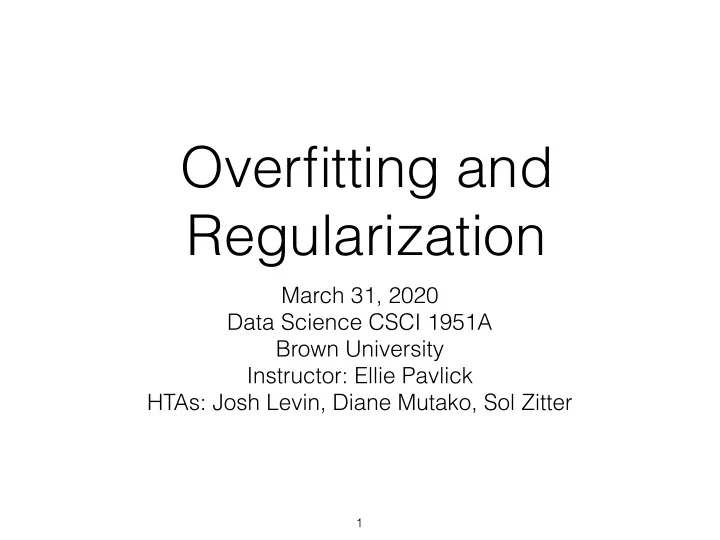

Overfitting and Regularization March 31, 2020 Data Science CSCI 1951A Brown University Instructor: Ellie Pavlick HTAs: Josh Levin, Diane Mutako, Sol Zitter 1
Announcements • Office Hours—watch calendar • ML assignment out later today • Analysis project deliverable out soon
Today • Overfitting and Regularization
Train/Test Splits • By definition, trained models are minimizing their objective for the data they see, but not for the data they don’t see • What we really care about is how the model does on data we don’t see • So we split our training data into disjoin sets—a train set and a test set—and assess performance on test given parameters set using train.
Train/Test Splits 5
Train/Test Splits Train 6
Train/Test Splits Train MSE = 6 7
Train/Test Splits Test 8
Train/Test Splits Test MSE = 12 9
Train/Test Splits Problem gets worse as models get more powerful/flexible Train MSE = 4 10
Train/Test Splits Problem gets worse as models get more powerful/flexible MSE = 14 11
Cross Validation • Some train/test splits are harder than others • To get a more stable estimate of test performance, we can use cross validation accs = [] for i in range(num_folds): train, test = random.split(data) clf.fit(train) accs.append(clf.score(test))
Overfitting • Models are likely to overfit when the model is more “complex” than is needed to explain the variation we care about • “Complex” generally means the number of parameters (i.e. features) is high • When the number of parameters is >= the number of observations, you can trivially memorize your training data, often without learning anything generalizable to test time
Regularization • Incur a cost for including more features (more non-zero weights), or for assuming features are very important (more higher weights) • Or “early stopping”—for iterative training procedures (i.e. gradient descent) stop before the model has fully converged (i.e. you assume the final steps are spent memorizing noise) • By definition regularization will make your model worse during training… • But hopefully better at test (which is what you really care about)
<latexit sha1_base64="W8ULAvdO+AKQ8XWFOrbuSfWxYPM=">ACJHicbVDLSgMxFM3UV62vUZdugkVoEcqMCArdFN24rGAf0Cklk6ZtaCYZkjtiKf0YN/6KGxc+cOHGbzFtZ6GtBwKHc85Nck8YC27A876czMrq2vpGdjO3tb2zu+fuH9SNSjRlNaqE0s2QGCa4ZDXgIFgz1oxEoWCNcHg9Rv3TBu5B2MYtaOSF/yHqcErNRxyxGXnQAGDAgOQt4vCGVM4aGM51oRn+JA2Ou6BFNloJDK02ix4+a9kjcDXiZ+SvIoRbXjvgdRZOISaCGNPyvRjaY6KBU8EmuSAxLCZ0SPqsZakETPt8WzJCT6xShf3lLZHAp6pvyfGJDJmFIU2GREYmEVvKv7ntRLoXbHXMYJMEnD/USgUHhaWO4yzWjIEaWEKq5/SumA6IJBdtrzpbgL68TOpnJd8r+bfn+cpVWkcWHaFjVEA+ukAVdIOqIYoekTP6BW9OU/Oi/PhfM6jGSedOUR/4Hz/AOuvo7Y=</latexit> <latexit sha1_base64="W8ULAvdO+AKQ8XWFOrbuSfWxYPM=">ACJHicbVDLSgMxFM3UV62vUZdugkVoEcqMCArdFN24rGAf0Cklk6ZtaCYZkjtiKf0YN/6KGxc+cOHGbzFtZ6GtBwKHc85Nck8YC27A876czMrq2vpGdjO3tb2zu+fuH9SNSjRlNaqE0s2QGCa4ZDXgIFgz1oxEoWCNcHg9Rv3TBu5B2MYtaOSF/yHqcErNRxyxGXnQAGDAgOQt4vCGVM4aGM51oRn+JA2Ou6BFNloJDK02ix4+a9kjcDXiZ+SvIoRbXjvgdRZOISaCGNPyvRjaY6KBU8EmuSAxLCZ0SPqsZakETPt8WzJCT6xShf3lLZHAp6pvyfGJDJmFIU2GREYmEVvKv7ntRLoXbHXMYJMEnD/USgUHhaWO4yzWjIEaWEKq5/SumA6IJBdtrzpbgL68TOpnJd8r+bfn+cpVWkcWHaFjVEA+ukAVdIOqIYoekTP6BW9OU/Oi/PhfM6jGSedOUR/4Hz/AOuvo7Y=</latexit> <latexit sha1_base64="W8ULAvdO+AKQ8XWFOrbuSfWxYPM=">ACJHicbVDLSgMxFM3UV62vUZdugkVoEcqMCArdFN24rGAf0Cklk6ZtaCYZkjtiKf0YN/6KGxc+cOHGbzFtZ6GtBwKHc85Nck8YC27A876czMrq2vpGdjO3tb2zu+fuH9SNSjRlNaqE0s2QGCa4ZDXgIFgz1oxEoWCNcHg9Rv3TBu5B2MYtaOSF/yHqcErNRxyxGXnQAGDAgOQt4vCGVM4aGM51oRn+JA2Ou6BFNloJDK02ix4+a9kjcDXiZ+SvIoRbXjvgdRZOISaCGNPyvRjaY6KBU8EmuSAxLCZ0SPqsZakETPt8WzJCT6xShf3lLZHAp6pvyfGJDJmFIU2GREYmEVvKv7ntRLoXbHXMYJMEnD/USgUHhaWO4yzWjIEaWEKq5/SumA6IJBdtrzpbgL68TOpnJd8r+bfn+cpVWkcWHaFjVEA+ukAVdIOqIYoekTP6BW9OU/Oi/PhfM6jGSedOUR/4Hz/AOuvo7Y=</latexit> <latexit sha1_base64="W8ULAvdO+AKQ8XWFOrbuSfWxYPM=">ACJHicbVDLSgMxFM3UV62vUZdugkVoEcqMCArdFN24rGAf0Cklk6ZtaCYZkjtiKf0YN/6KGxc+cOHGbzFtZ6GtBwKHc85Nck8YC27A876czMrq2vpGdjO3tb2zu+fuH9SNSjRlNaqE0s2QGCa4ZDXgIFgz1oxEoWCNcHg9Rv3TBu5B2MYtaOSF/yHqcErNRxyxGXnQAGDAgOQt4vCGVM4aGM51oRn+JA2Ou6BFNloJDK02ix4+a9kjcDXiZ+SvIoRbXjvgdRZOISaCGNPyvRjaY6KBU8EmuSAxLCZ0SPqsZakETPt8WzJCT6xShf3lLZHAp6pvyfGJDJmFIU2GREYmEVvKv7ntRLoXbHXMYJMEnD/USgUHhaWO4yzWjIEaWEKq5/SumA6IJBdtrzpbgL68TOpnJd8r+bfn+cpVWkcWHaFjVEA+ukAVdIOqIYoekTP6BW9OU/Oi/PhfM6jGSedOUR/4Hz/AOuvo7Y=</latexit> Regularization � � loss ( x ; θ ) + λ cost ( θ ) min θ • Adds an extra “hyperparameter” which controls how much you penalize
Dev/Validation Sets • Often you need to make meta-decisions (not just set the parameters), E.g. • Which model is better (i.e. generalizes better to held out data)? • What regularization to use? • How many training iterations? • Do do this, you have to split into train/dev/test, not just train/dev. If you use test to set these parameters, you are “peaking” at unseen data in order to fit the model, and thus test performance is no longer actually representative of how you would do in the real world
Recommend
More recommend